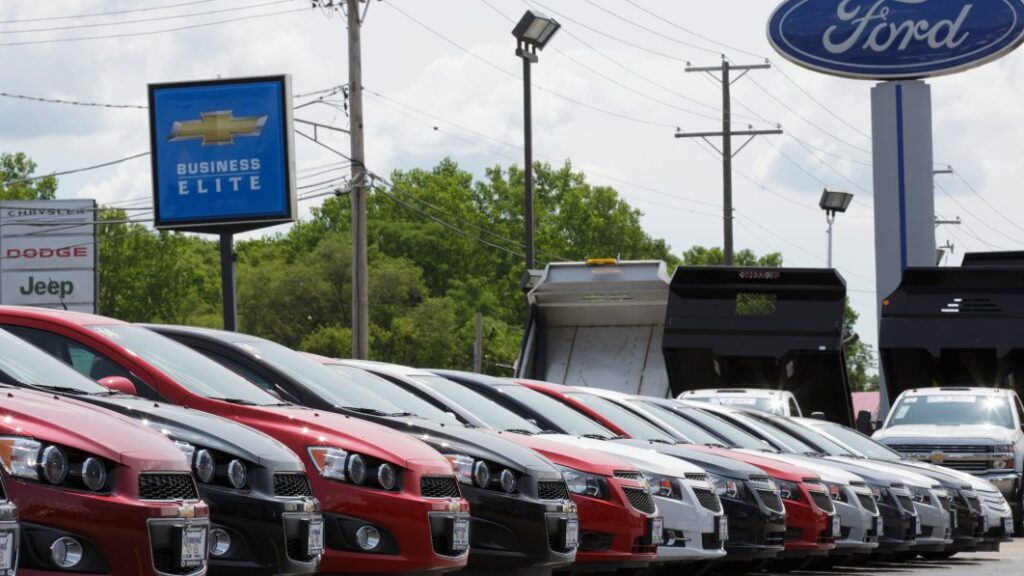If Ford and GM want to catch Tesla, they'll have to offer fewer options on your new car

Car buyers are used to having choices. As more automakers copy
Tesla and the budding Chinese manufacturers, that’s shifting.
John Gress/Corbis/Getty Images
American and German car buyers have long had myriad customization options to pick from.
Tesla and automakers in China have found ease and success in having fewer options.
Legacy auto companies might continue to copy the rival business model and cut their choices down.
Car buyers like having options — but as the Tesla and Chinese automakers continue to find success in electric vehicles, old-guard automakers would do well to force buyers to compromise.
Mainstay automakers from Detroit and Germany, to name a few, have long prided themselves on variety, giving their customers myriad choices not only in vehicle type, but trim, color, features, and options.
Meanwhile, car shoppers buying from Tesla have had fewer configurations to choose from. Elon Musk’s automaker has pared down the build options it gives customers to fewer color options and interior choices, limited trims, and many features that simply come standard. The budding Chinese EV-makers operate similarly, with much success.
The more options from a car company, the more complex its assembly process
If an automaker has 100 customer orders for the same vehicle model, but each with different variations, it’s more challenging and time-consuming to get those out the door. The lack of build complexity has been an advantage for Tesla, startup EV makers, and Chinese competitors, experts say.
“We see many of these new players aggressively managing build complexity – within a vehicle family and across their entire product portfolio,” Brian Irwin, managing director of Alvarez and Marsal’s automotive industry consulting group, said. For example, using a common center console across all vehicle programs. can keep things lean, he said.
It’s something automakers had to experiment with for cost-savings amid the 2008 recession.
Now, companies are doing it voluntarily — and it’s especially crucial as many of them are losing billions of dollars making EVs while their popularity is still ramping up.
“A number of the new Chinese BEV automakers design and engineer vehicles that are highly standardized around common platforms, components and architectures,” Irwin added. This creates “significant cost advantages across engineering, purchasing, manufacturing and service, in addition to supplier piece cost savings and improved quality.”
Ford and GM are already starting to take note
Automakers are starting to take a lesson from these other firms given their strong hold on market share and profits.
Tesla, which is hitting record monthly production and delivery numbers, has long been the EV market leader. Its profitability and market share are waning as the price war and increasing competition surface, but it still has a lead. As for the Chinese companies, their model is clearly working as well — those firms made major gains on non-Chinese automakers in China last year, and continue to have an upward trajectory.
“This new market dynamic is not lost on the traditional OEMs that are carefully watching the actions of the new upstarts,” Irwin said. “A number of the traditional players have initiatives underway to benchmark the build complexity of their start-up competitors.”
Ford executives have indicated they are already following suit.
“We have to bring our complexity down to get our build materials kind of in line with competition,” Ford CEO Jim Farley told investors in a July 2022 earnings call.
“We cannot just continue to build this complexity in our business,” Farley added, noting the company’s Blue division (focused on its internal combustion engine vehicles) would see less complexity. For Ford customers, the company’s CFO said that could reduce consumer options by “80% to 90%.”
GM is also “embracing a strategy we call ‘winning with simplicity’ that will reduce design and engineering expense, supplier cost, order complexity, build up of combinations and manufacturing complexity,” CEO Mary Barra said in July. “Our teams are applying even greater discipline around our color and trim pallet, the way we package features and options and reuse.
That could result in as much as “a 50% reduction in trim levels through a smart bundling of customer features and options,” Barra said.
Mercedes-Benz and Subaru have also implemented the strategy.
It might mean consumers have fewer options to pick from themselves — but perhaps the vehicles that are available more frequently come with what they want and need.
Ultimately, “managing build combinations and complexity is a high-wire act that requires a keen eye on customer preference,” Irwin said.



